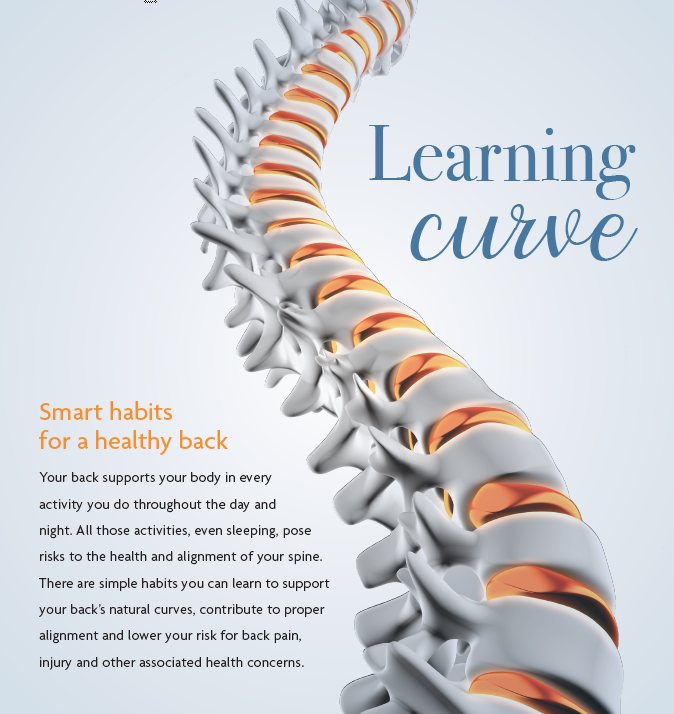Live Well
Learning Curve: Smart Habits for a Healthy Back

Your back supports your body in every activity you do throughout the day and night. All those activities, even sleeping, pose risks to the health and alignment of your spine that can compromise the strength of both your back and your health overall.
Back pain affects nearly 1 in 10 people worldwide. It can negatively affect your quality of life and increase the risk of other health problems. Chronic neck and back pain have been associated with an increased risk for mood disorders, alcohol abuse and anxiety disorders.
A healthy spine has three natural curves. When these curves are in proper alignment, your spine and major joints are in balance, and your body weight is evenly distributed. There are simple habits you can learn to support your back’s healthy curves, contribute to proper alignment and lower your risk for back pain, injury and other health concerns.
Strengthen Your Core
One of the most common causes for back pain is muscle imbalance. When the muscles of the back or abdomen are weak, they cannot sufficiently support the weight of the body. This is one of the reasons that back pain is more common among people who are not physically fit.
Walking briskly with your head held high and stomach muscles pulled in and tight for 20 – 30 minutes a day is a great way to build strength in your core muscles. The stronger your core, the better chance you have for reducing or protecting yourself from back pain and injury. Low-stress aerobic activities like walking, swimming, yoga, Pilates and tai chi are also recommended for toning your muscles and relieving back pain.
Improve Your Posture
Don’t slouch when sitting or standing. Your spine is most effective in supporting the weight of your body from its natural upright position. Slouching increases the burden on your spine and causes tension in muscles throughout your body that must compensate to support your weight and movements.
When standing, keep your weight balanced between your feet. When sitting, choose a chair that provides good lumbar support and is the proper position and height for whatever task you may be performing. To prevent muscle fatigue, avoid staying in one position for a long time. Shift your position periodically or get up to move around every 30 minutes to an hour.
Maintain a Healthy Weight
As previously mentioned, moving often is a great habit for keeping your back muscles strong and reducing back pain. Along with proper nutrition, it will also prevent excessive weight gain. Carrying extra weight around the waistline especially taxes back muscles. A diet focused on calcium, phosphorus and vitamin D also supports back health by promoting new bone growth.
Shop for Support
In addition to the daily habits we create for our bodies, the environments where we live and work also affect our back health. By making smarter purchases for our homes, offices and even our wardrobes, we can make sure our back muscles are comfortable and supported 24 hours a day to prevent the muscular imbalances and soreness that can cause back pain and injury.
Sleeping on a firm, comfortable mattress with supportive pillows is recommended for reducing and preventing back pain. To maintain the normal curves in your spine, try putting a small pillow under your neck and a rolled sheet or towel at your lower back. Chairs and couches should offer firm contours to support your spine’s curves as you work or relax at home. Comfortable low-heeled shoes are recommended to prevent back pain and injury.
When to See a Doctor and What to Expect
If you experience intense or persistent back pain, you should consult your doctor. Your medical history and a physical exam can usually identify any serious conditions that may be causing back pain. In some cases, testing may be ordered to rule out specific concerns. Your doctor may order an X-ray, computerized tomography (CT), magnetic resonance imaging (MRI), ultrasound or other imaging tests to detect injury, misalignment, infection or inflammation. Your doctor can also advise you as you explore ways to add smart back habits into your daily life.
Learning how to support the natural curves of your spine will prepare you for a lifetime of strength for your back and your overall health.
*Statistics and information are accurate as of the time of publication and may change over time.
